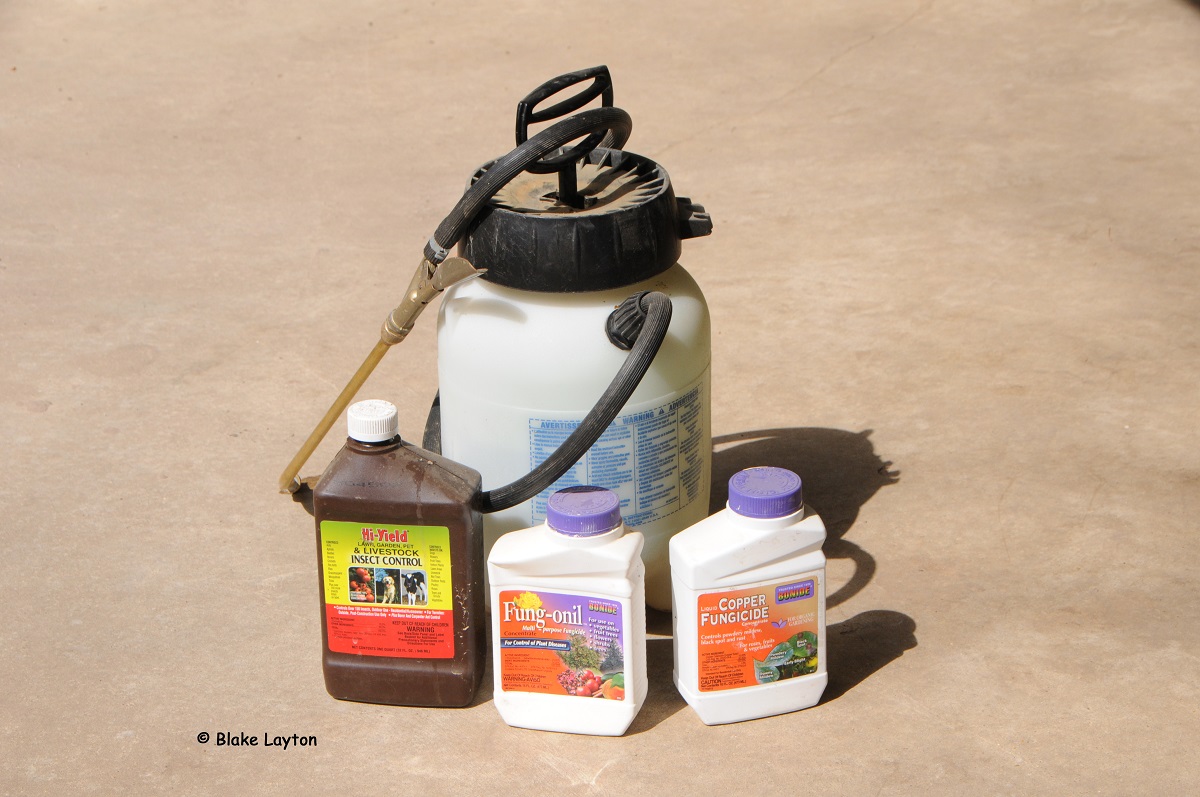Tomato Spray Mix, Vol. 6, No. 8
Related News
April 11, 2013
April 2, 2013
March 14, 2013
February 28, 2013

What do you spray to control insect and disease pests on your tomatoes? As a gardener who is also an entomologist, this is a question I am often asked. Although there is no one tank mix that works for every situation, and it is important to rotate to active ingredients with different modes of action to prevent resistance, the tank-mix shown below is one that I often use in my own garden. The permethrin controls fruitworms, hornworms, stink bugs and leaffooted bugs and the other two products are for disease control. There’s not much point in spraying for insects without spraying for diseases as well.
| Active Ingredient * | Amount/Gallon | Pre-Harvest Interval | Target Pests |
|---|---|---|---|
| Permethrin 10% | 2.25 tsp | 0 | fruitworms, hornworms, stink bugs, leaf footed bugs (not for aphids, mites, or whiteflies) |
| Chlorothalonil 29.6% | 2.5 tsp | 0 | fungal diseases |
| Copper Octanoate 10% | 1 to 2 fl oz | 0 | bacterial and fungal diseases |
*Rates may vary. Carefully read and follow label directions for all products used. Do not overuse these active ingredients; alternate with other recommended treatments to prevent resistance.
These active ingredients are all in products that can be purchased from local lawn and garden centers in small, home garden-sized containers. All three products are tank mixed according to label directions and applied as a single spray, taking care to get thorough spray coverage of the entire plant, especially the undersides of leaves. I usually begin spraying a week or two after setting transplants and continue spraying at 7 to 10-day intervals for the remainder of the season.
Although all three of these products have a 0-day pre-harvest interval, I usually try to allow a couple of extra days before resuming harvest. Pick first, spray later that day, wait two to three days before picking again, and wash or peel fruit before eating. As long as I maintain this spray schedule, we enjoy good insect and disease control. Once I start missing a few sprays, pest problems increase and fruit quality declines drastically.
Rotating active ingredients helps prevent the development of resistance. Mancozeb is a good alternative for chlorothalonil, but, because it has a 5-day preharvest interval, it is best used in early season. If caterpillar pests are your only insect concern, spinosad is an effective alternative for permethrin, but spinosad does not control stink bugs and is best used in early season when stink bugs numbers are low. Zeta-cypermethrin is a good substitute for permethrin, but because these both belong to the same insecticide class, switching between permethrin and zeta-cypermethrin does not help prevent resistance.
What about organic options? There are several organic fungicide products, and organic insecticides that contain spinosad will do a great job controlling fruitworms and hornworms. But other than hand-picking and foot-stomping, there are no good organic options for stink bugs and leaffooted bugs.
See Extension Publication 2347, Insect Pests of the Home Vegetable Garden, for more information on insect control, including examples of brand name products that contain some of the active ingredients mentioned here.
See Extension Publication 3175, Common Diseases of Tomatoes, for information on tomato diseases—also with examples of brand name products.
Thanks to Extension Plant Pathologist, Dr. Rebecca Melanson, for her input on disease control.
Blake Layton, Extension Entomology Specialist, Mississippi State University Extension Service.
The information given here is for educational purposes only. Always read and follow current label directions. Specific commercial products are mentioned as examples only and reference to specific products or trade names is made with the understanding that no discrimination is intended to other products that may also be suitable and appropriately labeled.
Mississippi State University is an equal opportunity institution.